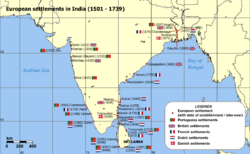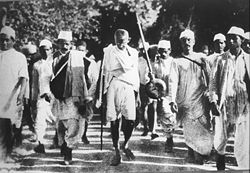Portuguese India
|
|||||||||||||||||||||||||||||||||||||||||||||||||
Portuguese India (Portuguese: Índia Portuguesa or Estado da Índia) was the aggregate of Portugal's colonial holdings in India. At the time of British India's independence in 1947, Portuguese India included a number of enclaves on India's western coast, including Goa proper, as well as the coastal enclaves of Daman (Port: Damão) and Diu, and the enclaves of Dadra and Nagar Haveli, which lie inland from Daman. The territories of Portuguese India were sometimes referred to collectively as Goa.
Contents |
Early history
The first Portuguese encounter with India was on May 20 1498 when Vasco da Gama landed in Calicut (Kozhikode) in the present-day Indian state of Kerala . Over the objections of Arab merchants, Gama secured an ambiguous letter of concession for trading rights from the Zamorin, Calicut's local ruler, but had to sail off without warning after the Zamorin insisted on his leaving behind all his goods as collateral. Gama kept his goods, but left behind a few Portuguese with orders to start a trading post.
In 1510, Portuguese admiral Afonso de Albuquerque defeated the Bijapur sultans on behalf of a local sovereign, Timayya, leading to the establishment of a permanent settlement in Velha Goa (or Old Goa). The Southern Province, also known simply as Goa, was the headquarters of Portuguese India, and seat of the Portuguese viceroy who governed the Portuguese possessions in Asia.
The Portuguese acquired several territories from the Sultans of Gujarat: Daman (occupied 1531, formally ceded 1539); Salsette, Bombay, and Baçaim (occupied 1534); and Diu (ceded 1535).

These possessions became the Northern Province of Portuguese India, which extended almost 100 km along the coast from Daman to Chaul, and in places 30–50 km inland. The province was ruled from the fortress-town of Baçaim. Bombay (present day Mumbai) was given to Britain in 1661 as part of the Portuguese Princess Catherine of Braganza's dowry to Charles II of England. Most of the Northern Province was lost to the Marathas in 1739, and Portugal acquired Dadra and Nagar Haveli in 1779.
After India's independence
| Colonial India |
|||||
| Portuguese India | 1510–1961 | ||||
| Dutch India | 1605–1825 | ||||
| Danish India | 1696–1869 | ||||
| French India | 1759–1954 | ||||
| British Empire in India |
|||||
| East India Company | 1612–1757 | ||||
| Company rule in India | 1757–1857 | ||||
| British Raj | 1858–1947 | ||||
| British rule in Burma | 1826–1948 | ||||
| British India | 1612–1947 | ||||
| Princely States | 1765–1947 | ||||
| Partition of India | 1947 | ||||
After India's independence from the British in 1947, Portugal refused to accede to India's request to relinquish control of its Indian possessions.
On 24 July 1954 an organisation called "The United Front of Goans" took control of the enclave of Dadra. The remaining territory of Nagar Haveli was liberated by the Azad Gomantak Dal on 2nd August 1954. [1] The decision given by the International Court of Justice at The Hague, regarding access to Dadra and Nagar Haveli, was an impasse[2].
From 1954, peaceful Satyagrahis attempts from outside Goa at forcing the Portuguese to leave Goa were brutally suppressed.[3] Many revolts were quelled by the use of force and leaders eliminated or jailed. As a result, India closed its consulate (which had operated in Panjim since 1947) and imposed an economic embargo against the territories of Portuguese Goa. The Indian Government adopted a "wait and watch" attitude from 1955 to 1961 with numerous representations to the Portuguese Salazar regime and attempts to highlight the issue before the international community.[4] Eventually, in December 1961, India militarily invaded Goa, Daman and Diu, where they were faced with insufficient Portuguese resistance.[5][6] Portuguese armed forces had been instructed to either defeat the invaders or die, and though a cease-fire was decreed, an official truce was never signed. [7] Only meager resistance was offered due to the Portuguese army's poor firepower and size (only 3,300 men), against a fully-armed Indian force of over 30,000 with full Air and Naval support.[8] [9]. The territories were annexed to India on 19 December 1961.

Post-annexation
Status of the new territories
Dadra and Nagar Haveli existed as a de-facto independent entity from its liberation in 1954 until its merger with the Republic of India in 1961.
Following the annexation of Goa, Daman and Diu, the new territories became Union Territories within the Indian Union, now separately as Dadra and Nagar Haveli and Goa, Daman and Diu. Maj. Gen. K. P. Candeth was declared as military governor of Goa, Daman and Diu. Goa’s first general elections were held in 1963.
In 1967 a referendum was conducted where voters decided whether to merge Goa into the neighbouring state of Maharashtra. The anti-merger faction won, but full statehood was not conferred immediately. On 30th May 1987 Goa became the 25th state of the Indian Union. Daman and Diu was separated from Goa and continues to be administered as a Union territory.
The most drastic changes in Portuguese India after 1961 were the introduction of democratic elections, as well as the replacement of Portuguese with English as the general language of government and education. However the Indians allowed certain Portuguese institutions to continue unchanged. Amongst these were the land ownership system of the communidade where land was held by the community and was then leased out to individuals. The Indians left the Portuguese civil code unchanged in Goa, with the result that Goa today remains the only state in India with a common civil code that does not depend on religion.
Indo-Portuguese relations
The Salazar regime in Portugal refused to recognize Indian sovereignty over the annexed territories, which continued to be represented in Portugal's National Assembly until 1974. Following the Carnation Revolution that year, the new government in Lisbon restored diplomatic relations with India, and recognized Indian sovereignty over Goa, Daman and Diu. Portugal continued to give the citizens of Portuguese India automatic citizenship. However, since 2006, this has been restricted to those born during Portuguese rule.
Postage stamps and postal history
Early postal history of the colony is obscure, but regular mail is known to have been exchanged with Lisbon from 1825 on. Portugal had a postal convention with Great Britain, so much mail was probably routed through Bombay and carried on British packets. Portuguese postmarks are known from 1854, when a post office was opened in Goa. An extraterritorial British post office in Damaun was open between 1854 and November, 1883. British Indian postage stamps were also available at the Portuguese post office at Goa from 1854 until 1877. A Portuguese post office opened at Diu in 1880[10].
The first postage stamps of Portuguese India were issued 1 October 1871 for local use[11]. The design simply consisted of a denomination in the center, with an oval band containing the inscriptions "SERVIÇO POSTAL" and "INDIA POST". In 1877, Portugal included India in its standard "crown" issue and from 1886 on, the pattern of regular stamp issues followed closely that of the other Portuguese colonies, the main exception being a series of surcharges in 1912 produced by perforating existing stamps vertically through the middle and overprinting a new value on each side.
The last regular issue was on 25 June 1960, for the 500th anniversary of the death of Prince Henry the Navigator. Stamps of India were first used 29 December 1961, although the old stamps were accepted until 5 January 1962. Portugal continued to issue stamps for the lost colony but none were offered for sale in the colony's post offices, and are thus not considered valid stamps.
References
- ↑ Goa's Freedom Movement
- ↑ International Court of Justice Case Summaries, Case Concerning Right of Passage Over Indian Territory (Merits), Judgment of 12 April 1960
- ↑ Rear Admiral Satyindra Singh AVSM (Ret.), Blueprint to Bluewater, The Indian Navy, 1951-65
- ↑ Lambert Mascarenhas, "Goa's Freedom Movement," excerpted from Henry Scholberg, Archana Ashok Kakodkar and Carmo Azevedo, Bibliography of Goa and the Portuguese in India New Delhi, Promilla (1982)
- ↑ Government Polytechnic of Goa, "Liberation of Goa"
- ↑ ' "The Liberation of Goa: 1961" Bharat Rakshak, a Consortium of Indian Military Websites,'
- ↑ Fernando Zamith, "Invasão de Goa foi 'ilegal, ilegítima e contra os direitos humanos'", Diario de Noticias
- ↑ Jagan Pillarisetti, "The Liberation of Goa: 1961" Bharat Rakshak, a Consortium of Indian Military Websites
- ↑ Liberation of Goa, Maps of India
- ↑ Robson Lowe, Encyclopedia of British Empire Postage Stamps, v.III, London (1951), p. 288
- ↑ Gilbert Harrison and Lt. Francis H. Napier, Portuguese India, with Notes and Publishers' Prices Stanley Gibbons Philatelic Handbooks, London (1893)
See also
- List of colonial heads of Portuguese India
- The 1961 Armed Liberation/Invasion of Goa
- Portuguese Indian Rupia
- Portuguese Indian Escudo
- Konkani words from other languages
External links
- The GoaMog Information Resource Portal
- Goacom
- Summary of the judgment of the International Court of Justice in the Right of Passage over Indian Territory (Portugal vs. India) case
- Dutch Portuguese Colonial History Dutch Portuguese Colonial History: history of the Portuguese and the Dutch in Ceylon, India, Malacca, Bengal, Formosa, Africa, Brazil. Language Heritage, lists of remains, maps.
|
|||||
|
||||||||||||||||||||||||||||





